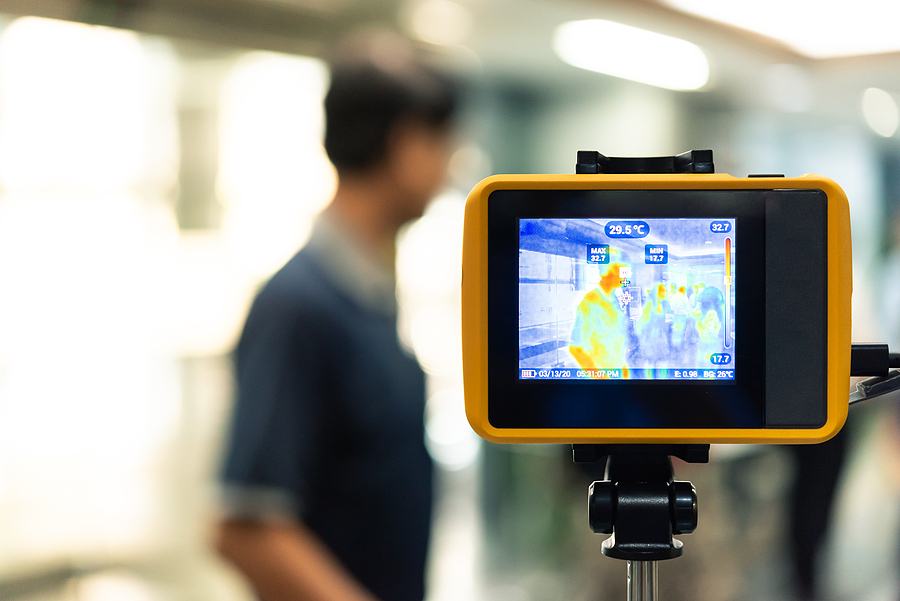
How to Automate COVID-19 Safety Protocols
Vaccine rollout is well underway in the U.S., painting a positive picture for the future. Still, it will take time for everyone to be fully vaccinated, and even then, COVID-19 safety protocols could linger for a while. In the meantime, workplaces can turn to automation to improve their anti-COVID-19 measures.
Temperature checks, social distancing, and mask mandates have become standard across many businesses. While necessary, enforcing these protocols can limit facilities’ productivity, as they rely on staff who could otherwise work on value-adding tasks. Since many companies had to reduce their active workforce by 39% on average, they need to improve productivity wherever possible.
Automating COVID-19 safety protocols also further removes employees from situations where they could contract the virus. Automation minimizes or eliminates close contact between workers during things like temperature checks.
Here’s how you can automate COVID-19 safety measures to stay safe and raise productivity.
1. Install Body Temperature Cameras
Temperature checks are one of the most common anti-COVID-19 measures, but they typically require close contact. Some businesses have found a way around this by installing thermal camera systems by employee entrances. These systems, which resemble metal detectors, scan worker temperatures as they walk, alerting relevant parties if they’re feverish.
Setting these systems up may be expensive at first, but you gain productivity in the process. The employee who would’ve performed temperature checks can instead work as usual, making your workplace more productive. Since these cameras can scan 30 people at once, they’re also more efficient than human-run checks.
Similar cameras throughout the workspace can detect if an employee develops a high temperature at work. You can then investigate further to determine if they need to go home or not.
2. Distribute Wearables for Social Distancing
Maintaining at least a 6-foot distance between workers is another crucial step in preventing COVID-19 outbreaks. Instituting a social distancing policy by itself isn’t enough to ensure people stay distant. It’s not economical to have managers monitor employees, either, so automation is the ideal solution.
Many warehouses and factories have turned to wearable technology to facilitate social distancing. These devices alert employees when they come within six feet of one another through noises and vibrations. These alerts are particularly helpful in areas with limited visibility where workers may not see each other.
You can’t expect to enforce social distancing by having managers roam the workspace. They can’t feasibly cover enough ground, and they could be working on more valuable tasks instead. Using wearables to maintain distance lets you keep employees safe without sacrificing productivity.

Photo by Torsten Dettlaff from Pexels
3. Use AI Cameras to Detect Masks
Masks are one of the simplest yet most effective ways to minimize the spread of COVID-19. Like with other regulations, though, mask mandates are only effective to the extent that employees comply with them. AI-enabled camera systems can detect if workers are wearing masks or not.
Machine vision systems can analyze video footage to see if anyone isn’t wearing a mask when they should be. You could deploy these with facial recognition to identify non-masked employees, but you may run into privacy concerns. An alternative would be a system that alerts managers when someone isn’t wearing a mask so they can look into it.
No matter what type of cameras you use, you should make sure your employees know about it. Privacy laws forbid employers from placing hidden cameras in private areas, and workers must know if and when you are recording them. Keep these factors in mind so you can protect employees from COVID-19 while preserving privacy rights.
4. Employ Sanitation Robots
Sanitation has found itself in the spotlight throughout the pandemic. Many businesses have adopted new cleanliness standards to eliminate cross-contamination and disease spreading through shared surfaces. Most companies pursue this by hiring cleaning crews or requiring workers to clean more frequently, which isn’t efficient.
A more cost-effective measure is to use sanitation robots. These automated cleaners are typically expensive but represent savings in the long run. Some take just 12 minutes to disinfect an area that would take a human worker more than an hour.
When you factor in how much it would take to pay a cleaning service over several months, the robots are more cost-efficient. Automation in this area also keeps people away from potentially contaminated surfaces, improving workplace health.
5. Implement Access Controls
Knowing where all employees are at any given time facilitates easier and more accurate contact tracing. Partitioning a workspace into separate zones can also help enable social distancing. To enforce these protocols more efficiently, you can use electronic access controls.
You can install locks that only open when workers scan their IDs. When employees have to scan into an area, you have a record of who was where if an outbreak occurs. You can then alert any other employees who might’ve contracted the virus so they can quarantine.
You could post workers by the doors to record who goes in and out, but that would be highly inefficient. Automatic access controls help ensure everyone working that day is adding value to the company.
Automation Improves Safety and Efficiency Amid COVID-19
Automating COVID-19 safety protocols lets you stay safe and maintain productivity. These solutions may come at a higher upfront cost, but their safety and efficiency benefits are impossible to ignore. They will also continue to help after the pandemic fades, ensuring productivity while preventing diseases like the flu.
COVID-19 has wreaked havoc on many businesses, but you can take measures to mitigate it. These five automation options will help keep your employees safe and efficient.
This article is written by Devin Partida. Devin is a tech writer with an interest in the IIot and manufacturing. She is also the Editor-in-Chief of ReHack.com.






